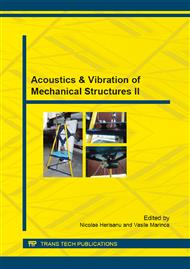p.122
p.129
p.136
p.142
p.148
p.154
p.159
p.165
p.171
On the Use of Higher-Order Frequencies in Crack Identification in Columns Subjected to Important Tip Mass
Abstract:
The paper present a novel non-destructive evaluation method designed to assess damage in structural elements subjected to important axial loads, as columns are. In the prior research a reliable damage detection method was developed for beams subjected to own mass, that consider the relation existing between the energy stored in the beam in certain vibration modes and the related natural frequencies. First we found the mathematical relations expressing the healthy pillar mode shapes and frequencies with respect to the top mass. Afterward, by means of FEM, we derived the natural frequencies for the numerous damage cases, in order to define the frequency shift curves. Analogous to the case of beams, the damage location is characterized by patterns that are derived from the mode shape curvatures square of the healthy beam. The damage location becomes an inverse problem while the damage position is found by interpreting frequency measurements made on the healthy and damaged beam.
Info:
Periodical:
Pages:
148-153
Citation:
Online since:
October 2015
Price:
Сopyright:
© 2015 Trans Tech Publications Ltd. All Rights Reserved
Share:
Citation:


